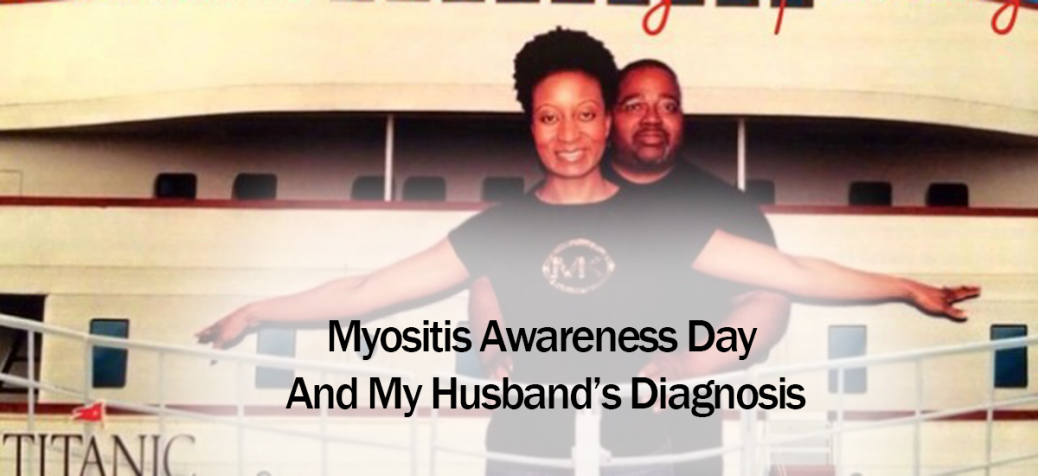Myositis Awareness Day And My Husband’s Diagnosis
by Guest Author, Barbara Naturally Speaking
It’s been almost three years since my life changed drastically in an unexpected way. My husband had been suffering from allergies that were recently diagnosed after he woke up with immense swelling in his face and lips in November 2012. He started getting allergy shots and then he just kept having swelling in his face, his lips, and his eyelids regardless of the treatment. He then started having weakness to the point that he couldn’t even lift himself to get out of bed. He also started sleeping for long hours and even walking a short distance became taxing. He also began wheezing so bad that at times I thought that he was asleep, when he was actually awake. His eyes were also extremely dry, as he kept rubbing them to try to create moisture. When his urine turned the color of Coca Cola, I began to pray even harder, called his father and brothers and said there’s something really seriously wrong with my hubby and that they needed to truly pray for him. I was terrified! My husband was out of it and I didn’t know if he knew how weak and sick he appeared to me. I took him to the hospital. That was the the beginning of a million hospital visits and doctors that couldn’t explain what was going on initially.
He was admitted into the hospital for a month. The hospital staff told us that his CPK numbers were through the roof. His CPK number was 25,000 and a normal CPK should be between 200 and 300. My initial response was CP-what? Apparently CPK stands for Creatine phosphokinase. CK is a type of protein called an enzyme. Myositis.org breaks it down this way: an indication of muscle damage, may be that muscles break open and spill their contents into the bloodstream. Due to most of the CPK existing in the muscle, a rise in CPK in the blood indicates that muscle damage has occurred.
In my husbands case, he was first diagnosed with Rhabdomyolisis. He was basically in kidney failure and his lack of movement was due to muscle damage, evidenced by the high CPK numbers. People don’t realize that muscles control everything for the body to function, to move, to live, including the heart and lungs. His muscle biopsy and blood tests all pointed to the final diagnosis of Polymyositis. My husband went through 6 months of treatment, physical therapy, occupational therapy, and speech language pathology evals to determine that his swallow was safe for food consumption, while being given high doses of prednisone and 5 other medications to maintain his function. They said, there’s no cure for this illness, and things can change from day-to-day, however he is currently functioning well, with daily trials that he’s managing.
 |
| My husband and I a few months after his release from the hospital |
No one on the outside really realizes his/our daily struggles including, increased time to get moving, tendency to focus when he walks to keep his balance, appreciation of me and our children for carrying things like groceries, the picnic chair, etc. to keep him from tiring out, or my tendency to drop him off near an entrance and then walk to meet him near the entrance so that he can reduce his fatigue. Sometimes I even get tired of explaining to numerous people who ask me about my husbands weight that prednisone causes fluid retention, especially in the face and mid-section, however I know they mean well.
One thing for sure, my husband is the most God-fearing, strongest, optimistic, handsome, and loving person that I know. We met in high school, went through college by each others side, and now as a couple in our forties with 3 children, we continue to take care of each other by being there in the midst of change and newly created roles in our lives. I thank God for each day that I’m able to love and support him the way that he’s always loved and supported me. We still laugh and joke with each other, which keeps us both smiling in spite of circumstances. I must say that over the past 3 weeks, he’s shown some significant improvements in his strength, mobility, and endurance and all we can do is thank God! I felt as if some family and friends turned their backs on us, however I realize that there are some situations in life that people will just not fully understand and empathize with unless they’ve experienced it. To the contrary, we had some family and friends that were so supportive and still are positive influences in our lives. I only give room to positive energy, as my focus is to put God first, my family, and then every thing else. We learned to appreciate each day to the fullest and to love thoroughly daily. One thing that I know is that through it all, “God is faithful.” When my husband was first discharged from the hospital he was so weak that he couldn’t even put his arms around me to hug me. Today he has the strength to hug me daily. His arms mean the world to me, after all he played football when I met him in high school. He will always be the big guy that I love!
Here are just a few facts about Myositis:
- It’s an autoimmune disease.
- Polymyositis affects more woman than men.
- There are different forms of Myositis: Inclusion Body Myositis, Polymyositis, Dermatomyositis, and Juvenile Myositis.
- The cause of Myositis is unknown.
- Polymyositis patients experience muscle weakness gradually, usually beginning with muscles closest to the bodies core (proximal muscles) i.e. neck, hips, back, the trunk area.
- Some patients have trouble swallowing, commonly known as dysphagia.
- Polymyositis can affect breathing, which can be a sign of inflammation in the lungs called interstitial lung disease.
- Pain and weakness in the muscles can also be found in patients with polymyositis.
Here are some tips for care partners/caregivers of patients with Myositis:
- Take care of yourself so that you can assist your loved one.
- Make time to do things that you enjoy i.e. read a book, work out with friends, take a dance class, join a walking group, as movement helps with stress.
- Advocate for your loved one.
- Chart down improvements and areas of concern to share with your loved ones medical team.
- Pray, love, live and encourage your loved one to do the same.
- Talk to a counselor for advice on handling a life changing situation, and encourage your loved one to do so also.
- Grieve the loss of your loved one as you knew them, and love, adapt, and support your loved one as they are.
- Join a caregiver/care partner support group.













This is such a great piece and shows how husband and wife can help each other and make their marriage stronger rather than being torn apart. Great job!